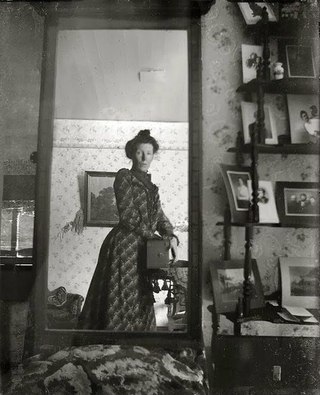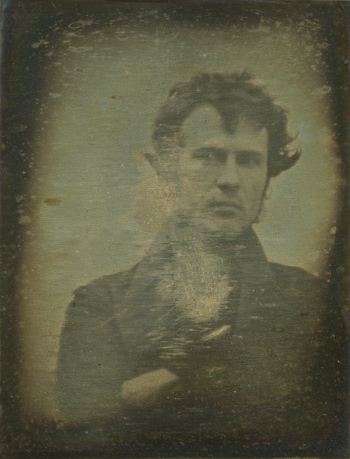Product links support this website. Details.
 Since I use a lot of vintage images in my art, I’m always interested in early photos.
Since I use a lot of vintage images in my art, I’m always interested in early photos.
Lately, I’ve been especially intrigued by “selfies” from the 19th and early 20th centuries.
However, not all of them are genuine. It may be important to watch for that, especially if you’re careful with copyright issues.
One of my favorite selfies is (supposedly) dated around 1900.
It’s shown at the right.
The largest version I can find was posted by Sabine Niedola.
Frankly, the subject’s features look a lot like my own portraits from the 1980s. I’ve tried that kind of hairstyle and – even with ultra-thick hair – it turned out the same as hers.
So, I wasn’t alone with the “pouf” issue. (Yes, I know about “rats” – long, sausage-shaped supports hidden under the hair – for better-looking versions of this style. I just wasn’t that committed to the style.)
Note: Since I posted this, my friend David Locicero pointed out authenticity issues.
This may be a hoax or a cosplay photo.
Something looks a little like an electrical outlet, on the lower right side of the photo. I’m not certain it’s an outlet, but it might be. I don’t know enough about household hardware from the early 20th century, to be sure.
My bigger question is about the matted photos on the shelves. The double-matted pictures are more consistent with modern-day presentations.
In the past, someone who could afford that kind of matting would have framed the photos under glass.
There’s also the question of the light fixture (if that’s what it is) on the ceiling in the reflection. And, the high quality of the mirror reflection.
But, whether it’s an authentic photo or not, it’s not the earliest “selfie.”
The Earliest Selfie?

One in the running for “first selfie, ever” is a self-portrait by photographer Robert Cornelius.
He’s the dashing young man in the photo on the left.
The fashions are, of course, post-Regency, but I still see a little Colin Firth / Pride and Prejudice in that photo.
Ah, if time travel were possible…! (If he came through a time portal, like in Kate and Leopold, I’m sure many women would swoon.)
For good reason, Mr. Cornelius has been featured as Victorian Hottie of the Week.
According to some, that’s his own photo from around 1839. Others simply say it’s the first actual portrait photo… taken by an unknown photographer.
It’s difficult to tell. Many websites give a nod to the Top 25 Most Ancient Historical Photographs as the source of Mr. Cornelius’ picture. That site says it’s a self-portrait.
You can learn more about him at this FindMyPast.com.au article, Historical ‘selfies’: in search of the world’s first self-portrait photograph.

Then there’s the Russian Grand Duchess Anastasia’s self-portrait, on the right, dating to 1913 or 1914.
The Daily Mail featured the picture in a really nice article.
I’d always hoped Anastasia had survived the attack on her family. Alas, DNA evidence suggests otherwise.
Nevertheless, I’m intrigued by the white blurry image in back of her. Online, that’s sparked some discussion with no firm conclusions. Very cool.
If you enjoy old self-portraits like these, visit Google or any search engine and look for “oldest selfies” and “earliest selfies.” You’ll find plenty.
(I’m not thrilled with the term “selfie,” or that it was the Oxford Dictionaries Word of the Year for 2013, but if you’re looking for early self-portraits, the term makes online searching much easier.)
Of course, watch out for faux historical selfies, created with the aid of Photoshop.
Amazon and the Amazon logo are trademarks of Amazon.com, Inc, or its affiliates. As an author and affiliate, I may earn a small commission if you purchase anything through my links. That does not affect the item's price, and I only link to products that I use and like, myself.

What a great post! I have been reading a lot about the value of “selfies” in modern culture. There is a suggestion that they reflect an unhealthy obsession with our physical appearance brought about by the media. Layering your article on top of my reading reminds me that we are creative creatures curious about this skin we are walking around in. The self portrait is a historically significant way of exploring that curiosity. Nothing new about it. What is new is that the masses have a camera in their hands mire than ever and the ability to share what they create has been magnified. Thank you.